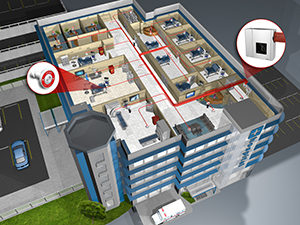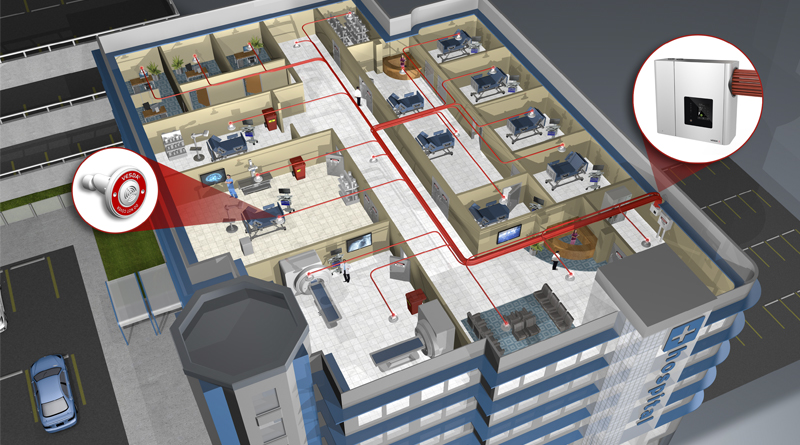Smoke Detector Alternative Promises Earlier Detection
By Sue Sadler
For decades, the traditional smoke detector was used to protect patients and personnel at health care facilities from the danger of smoke and fire – protection that is mandated by the National Fire Protection Association (NFPA).
Now, however, a new approach using more sophisticated, established smoke detection technology is contributing substantial benefits for health care facilities: lower overall costs, earlier detection and less disruption to patients during NFPA-mandated annual inspection and testing.
But first, do you need a smoke and carbon monoxide detector installing inside your property? For further information about the importance of reaching out to an electrician to take care of your fire prevention needs head to: aardvark-electric.com/electrical-services/smoke-co-detectors/.
Traditional Smoke Detectors
Traditional spot smoke detectors are installed in each room or space and connected to a central fire alarm panel by low-voltage electrical wiring. When a significant amount of smoke accumulates in the chamber of one of these smoke detectors, the alarm sounds. Although there are addressable systems on the market that can identify the specific room where such a threat occurs, many are not addressable and so only identify the zone. Finding the right smoke detector for your home or office could be a challenge, luckily there are professional electricians that can help you install the right smoke detector in your home. If you are looking for a licensed electrician, you can learn more about Kalahari Electrical Services or your nearest local service.

While spot smoke detectors are reliable and relatively easy to install, NFPA regulations also mandate an annual inspection and testing of each unit. This tedious and time-consuming process requires a fire alarm contractor to enter each room, introduce smoke directly into the detector and verify that it functions properly. This is often covered under ongoing maintenance contracts where fire alarm contractors make a significant amount of their profit.
In a health care environment, however, this can be extremely disruptive to patients, doctors, nurses and hospital personnel. The problem is exacerbated in psychiatric wards or hospitals, or for those in drug recovery, that are potentially even more sensitive to interruptions. Surgical rooms, NICUs, PICUs and emergency rooms are also an issue, given the sterile environment.
For Jeremy Robison, facilities director/safety officer at Sonora Behavioral Health in Tucson, Ariz., which is part of the larger Acadia Healthcare Group, the annual inspections required significant planning. For our patients, anything out of the ordinary, such as loud noises, can set them off,” Robison explained.
Once he became aware the maintenance provider would be coming for an inspection, Robison said he would send out advanced notifications by e-mail to alert both personnel and patients as well as to warn them of possible loud noise associated with testing. He would then have to figure out how to ensure that staff and patients were out of the rooms at specific times – a process that often required some creativity.
“One of the things I would try and do is schedule inspections for mealtimes, when the entire unit would be in the dining room,” said Robison.
Aspirating Technology
In smoke detection, more advanced technologies that provide earlier warning detection exist. These systems work by aspirating – or drawing in air – from each room through small, flexible tubing. The air is then analyzed to identify the presence of minute smoke particles in a continuous process. For almost 40 years, aspirating smoke detectors (ASD) have been used for the most sensitive applications where early detection of smoke or gas is critical, such as in cleanrooms, data centers and telecom facilities.
Recently, the technology has evolved to offer systems that combine the reliability and early detection of ASD with addressability in each room. These systems consist of small, flexible tubes that draw air through small, unobtrusive sample points in each room. The air is analyzed using sophisticated laser-based technology at the central unit located within 300 feet.
As a multi-channel, addressable system, the central unit can pinpoint the location of the alarm. A single system usually supports around 40 sample points and some can be extended to 120. For Robison, the addressability of the system had great appeal. He said the new systems using this technological advance was installed after it was specified by a consulting engineering firm during construction of a new building at the site in November 2016.
“I like how, if a smoke detector goes off in room 401, it tells you there is issue in room 401,” said Robison. “I don’t have to go through the entire unit, checking every one until I finally come across it.”
The system used at this facility is also sophisticated enough to allow for three levels of sensitivity to differentiate a fire from a patient smoking in a room, for example. This further minimizes disruption by reducing false alarms. Even with these benefits, one of the primary advantages of an aspirating smoke detector system is its ease of maintenance, inspection and servicing.
In compliance with NFPA 72 Chapter 14 requirements, systems like these do not require the contractor to enter each room. Instead, servicing and testing can be performed at the central unit and only takes a few seconds per sample point. In this way, the fire alarm contractor can complete the inspection at any time without having to move patients or access-restricted areas. By some estimates, this can greatly reduce maintenance and inspection costs and reduce the total cost of ownership of the fire alarm system by up to 60 percent.
Sue Sadler is the vice president and general manger of the Americas for Xtralis, a global company that pioneered ASD technology with the VESDA (Very Early Smoke Detection Apparatus) system in the 1980s. Xtralis has since evolved that technology to offer a system that combines the reliability and early detection of VESDA with addressability in each room, called VESDA-E VEA.

